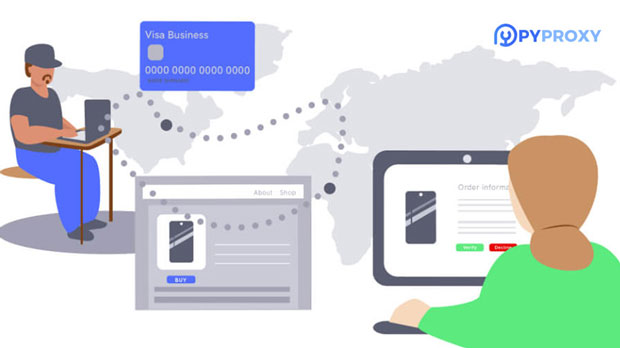The difference between Socks5 proxy server and Socks4 proxy server
In the modern Internet environment, proxy server has become a common tool to ensure anonymity, improve security, and break through geographical restrictions. The Socks protocol, as a universal network protocol, is widely used in the construction of proxy servers and the forwarding of network requests. At present, there are mainly two versions of the Socks protocol, Socks4 and Socks5, which have significant differences in functionality, performance, security, and other aspects. This article will provide a detailed comparison between the two and explore their applications in different scenarios to help users better choose the proxy protocol that suits their needsIntroduction to Socks4 Proxy Server The Socks4 proxy server is an early version of the Socks protocol designed to address IP address and port forwarding issues in network communication. The Socks4 proxy protocol is relatively simple and mainly uses TCP protocol for data forwarding. Its main characteristics are:1. Simple protocol: The structure of Socks4 protocol is relatively simple, without too many additional functions, and is easy to implement and deploy2. Only supports TCP: Socks4 proxy only supports TCP protocol data forwarding and does not support UDP protocol, which may cause inconvenience in some real-time application scenarios3. No authentication: Socks4 proxy does not provide authentication functionality by default, which means anyone who knows the proxy server address and port can directly use the proxy to access it4. Connection target: This protocol only connects through the IP address of the target server and does not provide domain name resolution functionalityAlthough Socks4 played an important role in early network environments, its limitations have gradually been exposed with the development of network technology, especially in terms of security, functionality, and flexibilityIntroduction to socks5 proxy Server socks5 proxy server is an upgraded version of the Socks protocol, which not only adds new features on the basis of Socks4, but also greatly improves the security and flexibility of the protocol. Compared with Socks4, Socks5 has the following significant features:1. Supports TCP and UDP protocols: Socks5 proxy not only supports TCP protocol data forwarding, but also UDP protocol forwarding, which is very important for real-time communication and online gaming applications2. Stronger security and authentication: The SockS5 protocol provides more flexible authentication methods, including username and password authentication mechanisms, to ensure that only authorized users can use proxy services. This increases the security of the proxy server3. Domain name resolution: The SockS5 protocol allows proxy servers to perform domain name resolution before forwarding data, so users can directly access the target server using the domain name without first resolving the IP address4. Stronger flexibility: SockS5 also supports IPV6, which can be compatible with more network environments, especially in today's era where IPv6 is gradually becoming popular, this feature is particularly important5. Support for multiple application protocols: SockS5 not only supports traditional applications such as HTTP and FTP, but also handles a wider range of network protocols, making it more versatileOverall, the SockS5 protocol has significant improvements in functionality, performance, and security compared to SockS4, making it suitable for more complex and diverse network requirementsDifferences in functionality between Socks4 and Socks5When analyzing the differences between Socks4 and Socks5 in depth, we need to compare their functions in detail from the following aspects: 1. Supported protocolsThe Socks4 protocol only supports TCP protocol connections, so it can only be used for traditional TCP protocol based applications such as web browsing and email transmission. In addition to supporting TCP protocol, SockS5 protocol also supports forwarding of UDP protocol, which enables it to support more real-time applications such as VoIP, online gaming, video conferencing, etcWhy is UDP support importantThe UDP protocol is different from the TCP protocol in that it does not have strict connection control and data acknowledgment mechanisms, making it more suitable for applications that require low latency and real-time performance. For real-time video and voice communication, UDP protocol has faster transmission speed, ensuring real-time data transmission without delay and congestion issues. SockS5 supports UDP forwarding, providing more support and assurance for these applications 2. Security and authenticationThe Socks4 protocol does not provide any authentication mechanism, which means that anyone can access the proxy server as long as they know the proxy's IP and port. Therefore, Socks4 poses certain security risks, especially in public proxy environmentsIn contrast, the SockS5 protocol provides multiple authentication methods, with the most common being authentication through username and password. Users need to verify their identity before using the proxy to ensure that only authorized users can use the proxy server. This feature greatly enhances the security of SockS5, avoiding abuse and unauthorized access 3. Domain name resolutionThe Socks4 protocol only supports IP addresses for connecting to the target server and does not support domain name resolution. This means that users must know the IP address of the target website in advance when using Socks4, otherwise they cannot access the website through a proxyThe SockS5 protocol allows proxy servers to perform domain name resolution, even if the user only knows the domain name of the target website, the SockS5 proxy server can automatically resolve and connect to the correct server. This design enhances flexibility, allowing users to directly use domain names without worrying about IP address changes 4. Connection methodThe Socks4 protocol only supports direct connection to the IP address and port of the target server, while the Socks5 protocol can provide more connection methods, including multiple intermediate nodes between the proxy server and the target server, which can enhance security and concealment in some casesIn addition, SockS5 supports connections to IPv6 addresses, while SockS4 only supports IPv4. This has become a very important feature in the context of the gradual transition of the Internet to IPv6Application scenarios of Socks4 and Socks5Different proxy protocols are suitable for different scenarios, and understanding their characteristics can help users choose the most suitable proxy service according to their needs 1. Application scenarios of Socks4Due to its simple structure, easy deployment, and implementation, the Socks4 protocol still has some practical value in some scenarios where security requirements are not high. Here are some typical application scenarios:-Simple anonymous browsing: If users only need to browse web pages anonymously through a proxy server and do not need to support UDP protocol, Socks4 may be a suitable choice. Its simplicity makes deployment and configuration very easy-Old version network environment: In some old version network environments that still use IPv4 or are based on traditional TCP protocols, Socks4 proxy can still meet basic network forwarding requirements-Devices with limited resources: On some devices with limited hardware resources, Socks4's lightweight features make it a suitable proxy protocol 2. Application scenarios of Socks5The Socks5 protocol is suitable for various application scenarios that require high performance and security due to its stronger security, higher flexibility, and support for multiple protocols. Here are some typical application scenarios:-Cross border visits: SockS5 can effectively bypass geographical location restrictions and is suitable for users who need to break through IP blocking and access restricted content-Real time applications: Due to SockS5's support for UDP protocol, it performs well in low latency applications such as real-time voice and video communication-High security requirements: If users have high security requirements, Socks5 can effectively prevent unauthorized users from accessing by providing username and password authentication functions-IPv6 support: For network environments that require compatibility with IPv6, SockS5 is an ideal choiceSummarySocks4 and Socks5, as two common proxy protocols, each have unique advantages and applicable scenarios. Due to its simplicity and low resource consumption, Socks4 still has a certain market in some basic applications, while Socks5 is widely used in modern network environments through enhanced security, support for UDP, domain name resolution capabilities, and other advantages. For most users who have high requirements for security, speed, and compatibility, Socks5 is undoubtedly a more ideal choice. When choosing a proxy protocol, users need to weigh functionality, performance, and security based on their actual needs and make the most appropriate decision
2025-01-08
























































